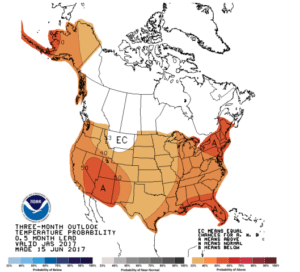The three-month outlook for July, August, and September currently depicts enhanced odds of warmer than normal temperatures. Meanwhile, the precipitation outlook for the same three-month time period places the region in an area of equal chances of above, near, or below normal precipitation totals (see the map).
From these trends, it is likely our 2017 crop will at least face heat stress. Should this stress develop within your crop, consider the below items:
- Be aware of the sensitive growth stages in your crop; for example, the pollination stage in corn and pod filling stage in soybeans are very heat-sensitive.
- One day of high temperatures (between 90-95 °F) doesn’t typically affect yield, but several sequential days of temperatures with that range coupled with water stress can certainly reduce the yield potential of corn and soybean.
- It is not easy to separate the effects of heat from drought (especially in soybean), but when the two stresses hit at the same time, impacts on yields are obviously increased exponentially.
Options to manage heat stress in-season are limited, but those with irrigated acres do have a few options:
- Irrigate with the appropriate amount of water based on checkbook methods or soil moisture sensors. Properly supplying the crop with water can prevent the exponential increase in yield penalties realized when heat and drought stress are both present in the field. For additional information, see https://news.utcrops.com/2017/06/irrigation-for-corn-and-soybeans/
- A quick run with the center pivot while applying 0.25-0.40 inch of water can cool the plant canopy and help enhance plant metabolic activities. If properly timed during a heat wave falling within the reproductive stages, this irrigation event can reduce the impact of heat stress on crop yields. Additional information on this approach can be found at http://cropwatch.unl.edu
Prior to planting, two other options which can help mitigate the potential negative impacts of heat stress include:
- Selecting the best planting date: Choosing the right planting date for the area which corn and soybean may face the heat stress later in the growing season is extremely important. Accurate planting date can give a chance to crop to escape the heat effects.
- Proper variety selection: Selecting the appropriate varieties, especially in soybean, based on a location can help to reduce the heat stress effects (e.g., drought/heat tolerant varieties).


